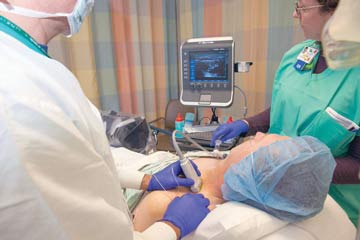Complications can occur when you send patients home with indwelling catheters and pain pumps. The catheter can kink or clog and the pump can malfunction, meaning the patient won’t get the analgesic needed to prevent breakthrough pain.
The other, more serious complications to watch for are infection, bleeding, migration of the catheter and the catheter getting ripped or torn with a residual piece remaining inside the patient. These are all potential and worrisome possibilities.
“Call patients at home — several times a day if necessary — to ensure the pain pump is working as intended, the patient’s pain is adequately controlled and to answer any questions they might have,” says Dr. Margulis.
During the calls, ask patients about these potential problems:
- Pump/catheter issues. If patients continue to experience excessive pain or the pain pump isn’t emptying at a steady rate, the pump could be malfunctioning, an obstruction could be preventing the medication from reaching
the patient or the anesthetic could be slowly leaking from the catheter.
Ms. Winchester says most at-home issues occur when the section of the catheter that sits outside the body bends as the patient moves and the dressing shifts. The part of the catheter that’s under the skin isn’t truly kinked or
clogged. “If this happens,” she says, “nurses can instruct patients on how to troubleshoot the problem.”
If, however, the catheter does become clogged or kinked, the patient will have to see a doctor or a nurse to have it removed and replaced. Depending on the comfort level of patients, they could remove catheters themselves before seeing a healthcare
provider.
It’s a fairly straightforward process. Patients should carefully remove the dressing and tape, so as to not tug on the catheter. They should then hold the catheter at its base, near the entry point, and slowly remove it. Patients need
to make sure the tip of the catheter comes out intact — holding and pulling the medication delivery tube away from the entry point during the removal process could cause the catheter to break. They should also check to make sure
there’s no swelling or redness at the insertion site. Minor bleeding isn’t uncommon after removal and can be stopped with a small bandage.
- Toxicity. Ms. Winchester says patients should know to look for the signs and symptoms of local anesthetic systemic toxicity (LAST). Although rare, LAST can occur if the large amounts of the local anesthetic reaches the
bloodstream or surrounding tissue.
LAST increases risk of cardiac complications and can cause seizures. Red flags include ringing in the ears and tingling throughout the blocked extremity. “If a patient reports any of these symptoms, they should clamp the catheter on
an elastomeric pump or turn an electronic pump off, and immediately go to an emergency room for care,” says Ms. Winchester.
- Infection. Infection rates associated with continuous catheters are very low, says Ms. Winchester. Indications of infection include fever, red or warm-to-the-touch skin at the insertion site, or a foul-smelling discharge
present where the catheter is placed. Patients who suspect the incision site is infected should contact a healthcare provider, remove the catheter and seek follow-up care.
“You have to explain to patients very carefully in a short period of time how the system they’ll be going home with will work, how to monitor the catheter placement, when it’s supposed to come out and what to look for while
it’s still inside them,” says Dr. Margulis. “I’ve therefore found that continuous catheters are most effective for patients who are active participants in their own care and able to follow detailed discharge instructions,
and who have a support structure in place at home.”
Choosing to place CNBs should ultimately be done on a case-by-case basis. Don’t let concerns about managing the blocks from afar prevent your patients from experiencing the benefits of longer-lasting pain relief that CNBs provide. With
proper oversight and planning, the analgesic benefits far outweigh the potential patient safety risks. OSM
.svg?sfvrsn=be606e78_3)

.svg?sfvrsn=56b2f850_5)